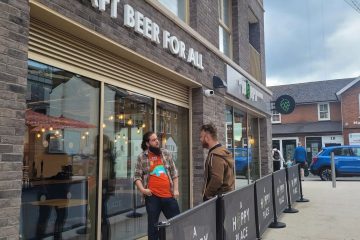Whilst exploring Southern California’s stunning Route 1 coastline back in May 2018, the differences in the way beer is sold in the USA and the UK could not have been more stark…
I’ve been a beer drinker since the age of 15. In my early days, most commonly my pint of choice was a “big beer lager” – Fosters, Carling, Heineken, Carlsberg or whatever. Not nice beer. Though I dispute for the most part whether they are “good beer” with craft drinkers – they are great beers in fact. (Any aspiring homebrewer will know how difficult it is to brew a consistent DMS low lager with absolute clarity, tasting the same batch to batch) However, I am totally onboard with accepting they are not “nice” beers.

The reason I got into such low strength sessionable lagers was a combination of cost and taste. As a kid mostly drinking full fat coke, who hated the taste of water, who didn’t even drink tea at the time – those lagers were appealing because basically, they tasted of nothing at all.
But to brew a beer like that requires vast, vast investment in equipment and in process. It’s actually ridiculously difficult to produce such a bland product consistently! And then there’s the issues of distribution. With very little craft beer scene to speak of in the UK 15 years ago, supply outstripped demand for the most part – pub freeholders and brewery chains set the prices extremely aggressively – making economies of scale even more critical. It is very difficult to compete with mass manufacturing on price…

The Campaign for better ale
I feel that the UK’s real ale scene today is for the most part struggling from some of the same challenges, but added to the above the additional risk of shelf stability and of oxidation once the product is tapped and vented. First of all, when competing for such low margins, the way we tax beer in the UK makes ABV a problem of sorts. You cannot have a retail price between £2.80 and £4 for any product above about 4%, because running at a margin of 20% or less is just not viable, rates being what they are in the South East. Further, once the beer is open – you’ve got to sell it in 3 days. Not a good scenario. Why would a brand new craft brewer attempt to disrupt the big brewery owned pub chains in this market?
Which leads me to the USA. Post prohibition, most states had very strict laws on distribution. It was oft franchise led, and that franchise is nearly always what the Americans call the red line or the blue line. Meaning, Miller Coors, or AB InBev. They also demand a price point per pint in line with what our UK PubCo’s demand. This makes entering the market incredibly difficult. People cannot make a living selling their beer that cheap. This is a big part of why at the lowest ebb, there were only 8 breweries left in the United States. Now, they open more than 8 per hour.
What has changed is that state by state, bill by bill, self-distribution viability has been pushed. On top of that, though only as recently as Q4 2018 in Georgia, breweries are now allowed to sell their product direct to the public for the first time. Before then, they had to sell very expensive brewery tours, with multiple ‘free beers’ included in the tours. A confusing grey area, and very difficult to manage. At least we never had those kind of issues this side of the Atlantic…

Disrupting megalith distributors and PubCo’s
Think about it though, if you can sell a barrel at 5 bucks a pint, making say 1700 dollars on the barrel, or sell the barrel for maybe 400 to a distributor, it becomes a very simple choice. Further, your minimum units of production selling the beer yourself is however much you can sell before the beer spoils – a distributor might demand 20, 50 or even more barrels as a minimum order. And even after all that you then need to hope they’ll market your product over all of their other lines, and not just let it go bad – and then not order off you again!
So the model of selling your own beer to avoid tying in with these megalith distro co’s is really what started the US taproom model. Cut out that aggressive yet indifferent middle-man and shift your stock. Carbonate that stock and keep the air off it, and your one keg can do 30, 60 days. You can sell 20 litres of a beer to your buddies over a 2 month period, brewed on a 1 barrel kit or less. This also means you can experiment!

In 3 weeks in the USA, my wife and I never tried the same beer twice. We weren’t even close to needing to. The level of experimentation possible due to direct sale is incredible. I had the privilege of visiting Sierra Nevada, whom are still a family owned craft brewery despite any reservations one might have about their size, tried the 12 or so beers they don’t distribute widely, then went on to San Diego and got lost in a sea of more craft brews than I could have tried in 6 months. At the other end of the scale to Sierra we also met a guy who’d converted the front room of his house into a taproom, and sold the beers he made in his garage. A bunch of them were excellent!
Multi-channel beer
aficionados
Beer is no longer boring. The small batch culture, experimentation and direct distribution models out there mean if the brewer wants to try something out, so long as it’s not actually spoiled, they will be able to sell it. Moreover, perhaps picking up on the gamer geek Pokemon style ‘gotta catch em all’ ethos that’s so readily enabled by social media and specialist apps like Untappd and Ratebeer, this experimentation is directly driving hype – driving demand – and driving craft beer to unprecedented heights.
People don’t want the same 6 beers to the exact same quality every time they go out for a drink. They want something new, to talk about. Beer is a destination now, not a route to drunkenness. I don’t go out to get drunk, I go out to drink beer. Most of my friends are the same.

This taproom model has absolutely come to the UK. We are riding the crest of a USA initiated craft beer revolution. London has seen over 100 new breweries open since 2010. Most of these sell out of taprooms. The successful, grow their model from there to wider distribution, before going nationwide. Beavertown started out of a small industrial unit before being 49% acquired in 2018 by Heineken. Brewdog were famously two men and a dog Homebrewing. The market facilitates not just microbreweries but nanobreweries and homebrewers dedicated to their craft being able to grow into genuinely disruptive market forces.

A crafty way in to big recognition
Siren Craft Beer in the UK recently made waves by winning Champion Beer of Britain – awarded by CAMRA. Craft Beer producers are now disrupting our UK big beer and cask beer markets. Kegged, interesting, rotational beers are at the heart of a market that grew by 23% in 2017 alone and is now responsible for a good 10% of beer sales. This is huge growth in a sector that is in decline overall. On the other hand, due to tax, due to volumes required limiting experimentation, and due just to the need to sell 72 pints or more of the stuff over a weekend, cask is in a period of decline – like it or not. Pubs that will not adapt to their market will close. They already have been. Most of them turn into flats.

In my opinion, To save our pubs, we need to accept the American way. That means accepting forced carbonation. Accepting kegs. I for one have no issues with that.
I myself have kicked on my homebrewing. I only make 5 litre batches, they take me a good month to put out, but the quality is slowly improving. What is genuinely exciting are the pathways for organic growth for someone who can self-distribute his own product. I totally see why so many homebrewers want to get into selling their beer. But in the mean-time, the USA taproom style market is barely getting off the ground here.
The shoots of a new market
I was recently back in the USA in Asheville North Carolina, and on the way hit up a Taco Mac. This fairly run-of-the-mill restaurant has on average more than 100 craft beers on tap, most local, and changing weekly. They have an app that allows you to check in unique brews and incentivises continued experimentation. They were founded in 2010 and have grown to 27 branches before being bought out in 2018.

Mad Squirrel based out of Hertfordshire, North West of London are the first UK taproom I am aware of implementing this model aggressively. This chain, starting with one taproom near their microbrewery, is about to open its’ 6th taproom outlet; with the model of a strong core range of their own beer and an always rotating guest selection. They recently crowdfunded further expansion, easily reaching 121% of their target in a UK sector that is shrinking overall
Tasting rooms, Bottle shops and Brewery Taps will be at the heart of craft beer expansion in the UK, and will be a genuinely exciting retail premise in the UK in the next 2-3 years. I expect to see hundreds more taprooms in the UK, because when I look back to my trips to the US last year – a market that itself is still growing massively, I look at what we have here and realise, we are barely getting started…



0 Comments